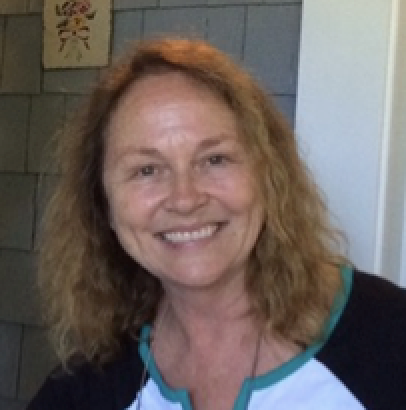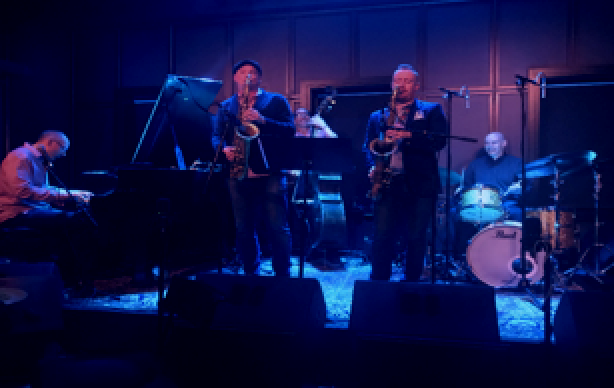|
A View from the Outside
Jazz: An Unspoken Language Players know what they’re saying, but not where the conversation will go. By Donna Knox Donna Knox is an attorney and a freelance copy & content writer. She is also a newcomer to the jazz scene and offers her observations from that unique perspective. As someone who only recently discovered the world of jazz, I’ve listened with the sophistication a child might bring to her first storybook — not much more than simple enjoyment and an appetite to learn more. Then I started going to live performances and saw the interaction between musicians. Only then did I appreciate the ways in which jazz is different from other music. I woke up to the language of jazz at The Press Room in downtown Portsmouth when I went to its regular Sunday Night Jazz a couple weeks ago. Upstairs, the newly renovated room was full of energy — a unique kind of energy, as crowded rooms go. Everyone was all kinda in there together, at separate tables but somehow chatting and joking with those to either side while waiting for the show to begin. That night The Press Room Trio (Ryan Parker on piano, Keala Kaumeheiwa on bass and Les Harris, Jr. on drums) were sidemen to two well-known and acclaimed saxophone players, Tucker Antell and Mike Tucker. I’ve spoken to Ryan Parker and the “Two Tuckers” since that evening. The three of them had interesting insights into how jazz musicians largely improvise when they’re on stage. Other genres of music, like rock & roll, often rely on a rehearsed play list which includes songs with lyrics that tell the story. But jazz wants freedom, according to Ryan Parker. You don’t have as much when there’s a vocalist. The freedom jazz musicians find is in the improvisation. Take the Sunday I was at The Press Room for example. The musicians were not in a regular band together. The two sax players were featured guests whose other musical endeavors cover vast territory which, for the most part, doesn’t involve each other. So, for that night, there had been no rehearsals. There was no Set List. The musicians had had a text thread going back and forth for a couple weeks tossing around ideas of songs they could play. They looked at some YouTube links. When they got to the club, they chatted for a few minutes. That was it. Then they got up and played. They could do so because, as experienced players, they all have a repertoire of songs in common and they know they’ve got to “stay awake” on stage: Listen. Watch. Follow where the music wants to take them. They have skills that allow them to say, “Okay, looks like he’s playing this, so I’ll play this.’’ Talking about improvisational jazz, Mike Tucker explained, “When we’re playing, it’s like having any conversation. We know the vocabulary and the phrases, but there’s no script. We’re playing extemporaneously.” Ryan Parker would add that telling the story is the hard part. The rhythm section (bass, drums and piano) provide time, harmony and foundation, but the story lies in the solo, he says. In this case it was the saxophones. So how do they keep it moving without awkward transitions or stepping all over each other? Turns out they’ve got a bunch of cues, most of which use body language to communicate as they move through a song. When Tucker Antell raises his sax, the others know something’s going to happen. If Mike Tucker turns around to the drummer, he’s going to take a solo. When another player makes eye contact, get ready. Eye contact always means something’s going to change. Sometimes, there might be a nod of the head. Or a fist in the air. Ryan could hold up four fingers, or just say “bridge” and everyone will know they’re leaving the solo in four measures. This language is so much a part of playing jazz that seasoned musicians take it for granted. It’s just how they communicate. No one’s lost in his music. They’re all keeping an eye out for who’s going to do what next. And, as Tucker put it, “It’s not an option to say no.” So, for instance, although the drummer usually supports the other players, if he decides to ratchet things up out of nowhere and get aggressive, forget the quiet little verse anyone else might’ve thought was coming up. They’ve all got to boogie. No one knows for sure who’s going to do what but, as Ryan says, “Just listen and you’ll hear it.” The night I was in the audience, the two Tuckers turned the last song, Eternal Triangle, into a repertoire shooting match, as Tucker described it. They were doing a duet. In the middle of the song, Tucker played a quote from another song. Mike recognized what Tucker had done and threw out a quote of his own from a different song. Tucker came back with a third, but Mike jumped into a fourth. And so it went. When they were ready to bring it to a close, they both played the same quote from the same song. After the first few notes, the bass player and drummer realized what was happening and transitioned to an end. None of it had been planned. None of us in the audience could tell. That’s how it goes with improvisational jazz. You can watch the duet for yourself here. And get a transcription here. I’ve stopped thinking in terms of going out to listen to some jazz. It’s so much more than that. Now I go out to see jazz. To take it all in. It’s more engaging now that I understand — and appreciate — the more nuanced skill and experience at work on stage. Lucky for me, and everyone else in the Seacoast area, there is lots of great jazz to go out and watch, not the least of which is at The Press Room on Sunday nights. In addition to playing piano with guest artists, Ryan Parker has been The Press Room’s programmer for the past 10 years. He tells me he’s mixing things up with different kinds of jazz these days. He and his Press Room Trio will host all sorts of styles and talent in the weeks to come, so we jazz enthusiasts will have a variety to keep us entertained. And, when it’s a night of improv jazz, look for the cues. See how the musicians hand off to each other. It’s fun to watch. And it makes the music even more remarkable. You can see replays of the Press Room’s Sunday Night Jazz on YouTube at Ryan Parker Jazz. To read more about these artists, visit their respective websites: Ryan Parker, Tucker Antell and Mike Tucker. All three are talented musicians with diverse contributions to the music scene—locally, around the country, and abroad. |
Copyright ©2024 Seacoast Jazz Society, All Rights Reserved



